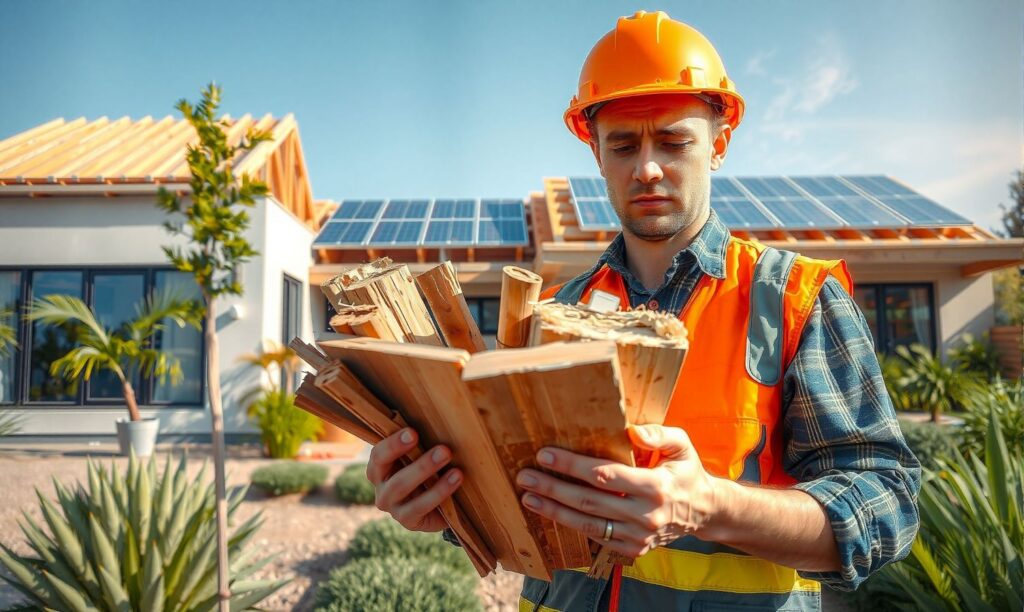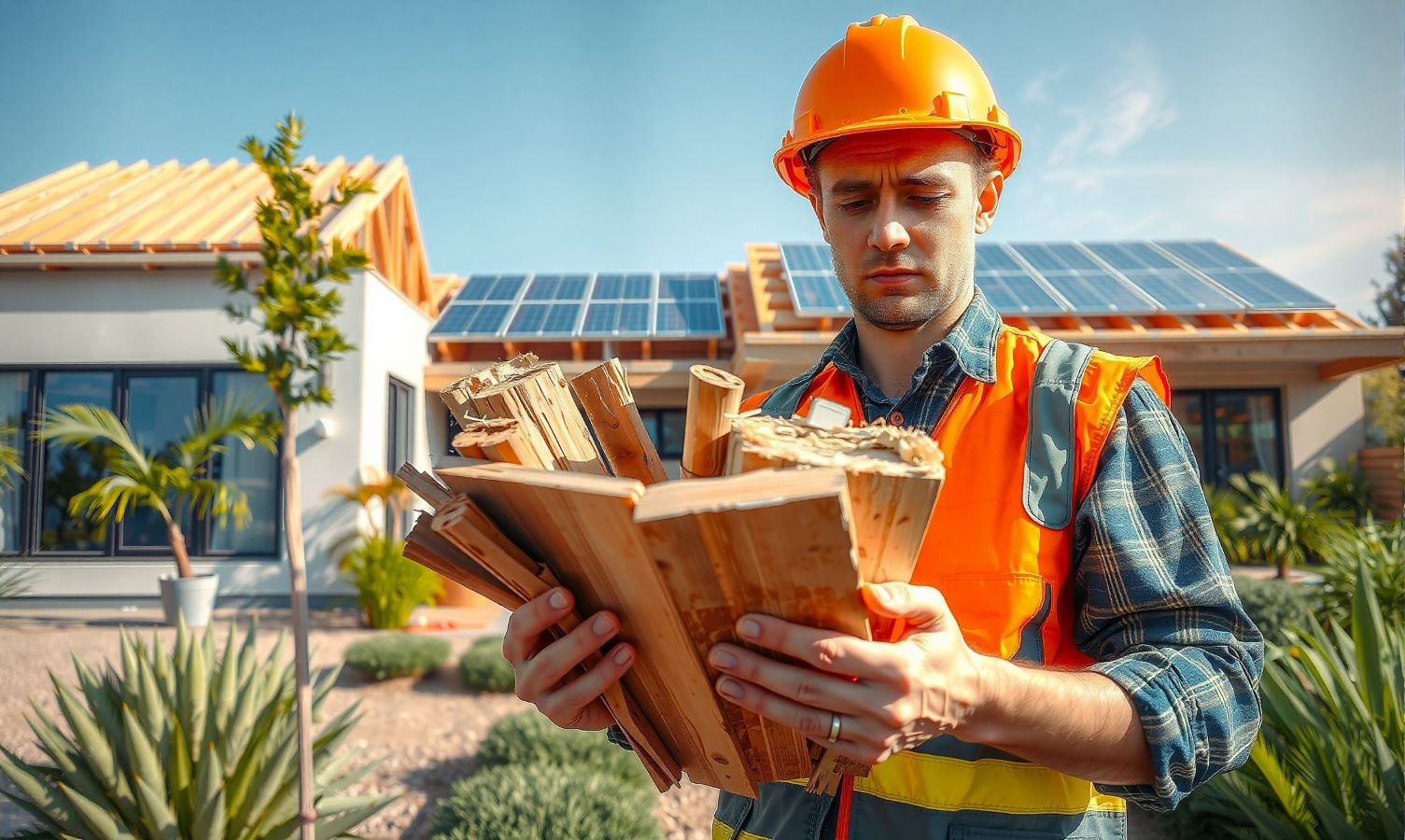
Introduction
Building a sustainable, zero-waste home on a 5-acre property isn’t just a dream—it’s a statement. A statement that shouts, ‘Hey world, I’m committed to doing my part for the environment!’ But let’s be honest, starting this journey can feel like navigating a dense forest without a map. You might find yourself wondering, “Where do I start? Which building materials are actually eco-friendly? How can I avoid making wasteful choices?”
Fear not! This guide will help you navigate the maze of eco-friendly building materials, giving you the tools to make informed decisions that align with your zero-waste goals. By the end, you’ll be ready to build a home that’s not just sustainable but also a place you can feel proud to call your own.
What is Zero-Waste Construction and Why Eco-Friendly Building Materials Matter
Zero-waste construction isn’t just a buzzword—it’s a philosophy that’s all about minimizing waste and maximizing resource efficiency in a large scale or DIY project. Essentially, it’s about creating a home where every piece of material serves a purpose, and nothing ends up in a landfill. Sounds pretty noble, right? But how do you achieve this on your 5-acre property?
The secret sauce is in the materials you choose. Eco-friendly building materials are the backbone of any zero-waste project. They’re the sturdy beams that hold your sustainable dreams together, quite literally. When you choose recycled, renewable, or naturally occurring materials, you not only reduce your environmental footprint but also set the foundation for a home that withstands the test of time. And the best part? Many of these materials are as durable and stylish as their conventional counterparts, so you don’t have to sacrifice aesthetics for sustainability.
Top Eco-Friendly Building Materials for Zero-Waste Construction
Now, let’s roll up our sleeves and dive into the nitty-gritty: the materials themselves. Whether you’re laying the foundation, putting up walls, or insulating your home, there are eco-friendly alternatives for nearly every aspect of construction.
Eco-Friendly Building Materials: How to Use Recycled Materials for Zero-Waste Construction
Recycled materials are like the unsung heroes of eco-friendly construction. They’ve been through the wringer, seen it all, and now they’re ready for a second (or third) life. Using recycled materials doesn’t just reduce waste; it also adds character and history to your home. Imagine telling your guests that the beams in your living room once supported an old barn or that your countertops come from recycled glass bottles. Pretty cool, right?
Here’s how you can incorporate recycled materials into your zero-waste build:
- Reclaimed Wood: Perfect for floors, beams, and even walls. It’s strong, full of character, and each piece tells a story.
- Recycled Steel: Great for framing. It’s durable, uses less energy to produce than new steel, and you can recycle it again at the end of its life.
- Recycled Glass: Ideal for countertops, tiles, and decorative elements. It’s versatile and adds a unique aesthetic to your space.
Renewable Resources for Eco-Friendly Construction
When it comes to renewable resources, bamboo is like the Usain Bolt of the plant world—fast-growing and incredibly strong. But bamboo isn’t the only renewable resource worth considering. Cork, straw bale, and even certain types of fast-growing wood can be fantastic options for your zero-waste construction project.
Let’s break it down:
- Bamboo: This rapid-growing grass is not just for pandas! Bamboo is incredibly strong and flexible, making it perfect for flooring, walls, and even structural elements.
- Cork: Cork is harvested from the bark of cork oak trees, which means the trees don’t have to be cut down. It’s naturally fire-resistant, hypoallergenic, and an excellent insulator.
- Straw Bale: Think of straw bales as the ultimate underdog in the construction world. They’re super insulating, easy to work with, and when properly maintained, they can last for centuries.
Natural Insulation Options for Eco-Friendly Homes
Insulating your home is like wrapping it in a cozy blanket—essential for comfort, but not all blankets (or insulation materials) offer the same quality. Natural insulation materials like wool, hemp, and cellulose are not only effective but also align perfectly with zero-waste principles.
Here’s what makes them stand out:
- Wool: Sheep’s wool isn’t just for sweaters. It’s naturally insulating, fire-resistant, and biodegradable. Plus, it absorbs moisture without losing its insulating properties, making it ideal for maintaining a comfortable indoor environment.
- Hemp: Hemp insulation is made from the fibers of the hemp plant. It’s mold-resistant, highly durable, and has excellent thermal properties. As an added bonus, it’s also good at absorbing sound, making your home a quiet retreat.
- Cellulose: Cellulose insulation is made from recycled paper products, primarily newspapers. It’s treated with non-toxic fire retardants and offers excellent thermal performance. Best of all, it keeps paper out of landfills.
Low-Impact Concrete Alternatives for Sustainable Building
Concrete is a staple in construction, but traditional concrete is far from eco-friendly. The good news is that there are low-impact alternatives that can help you achieve your zero-waste goals without compromising on strength or durability.
Here are a few to consider:
- Hempcrete: Made from hemp fibers and lime, hempcrete is a lightweight, insulating material that’s great for walls and floors. It’s breathable, which helps regulate indoor humidity, and it actually absorbs carbon dioxide over time, making it a carbon-negative material.
- Rammed Earth: This ancient building technique involves compacting layers of earth into a solid wall. Rammed earth walls offer incredible durability, excellent thermal mass, and use local, natural materials.
- Mycelium-Based Composites: Mycelium, the root structure of mushrooms, can be grown into strong, lightweight building blocks. These composites are fully biodegradable, meaning that at the end of their life, they can return to the earth with no waste.
How to Choose Eco-Friendly Windows and Doors for a Zero-Waste Build
Windows and doors are like the eyes and mouth of your home—they let in light, air, and, unfortunately, sometimes too much heat or cold. Choosing energy-efficient windows and doors is crucial for maintaining a comfortable indoor environment and reducing your energy consumption.
Here’s what to look for:
- Low-E Glass: This type of glass has a special coating that reflects heat while letting in natural light. It’s a must-have for any energy-efficient home.
- Sustainably Sourced Wood: When choosing wood for your windows and doors, opt for FSC-certified (Forest Stewardship Council) wood. This ensures that the wood was harvested sustainably.
- Proper Sealing: Don’t forget about the importance of proper sealing! Gaps around windows and doors can lead to significant energy loss. Look for materials that offer excellent insulation and durability.
Best Sustainable Roofing Materials for a Zero-Waste Home
The roof over your head should do more than just keep out the rain—it should also align with your sustainability goals. Luckily, there are several eco-friendly roofing options that can help you achieve a zero-waste build.
Green Roofs
Eco-Friendly Roofing Solutions Green roofs are like having a garden on your roof—literally. They involve growing plants on your roof, which helps insulate your home, reduce stormwater runoff, and create a habitat for wildlife.
To build a green roof, you’ll need materials like:
- Waterproof Membranes: These protect your home from leaks while supporting the weight of soil and plants.
- Root Barriers: These prevent roots from damaging your roof structure.
- Lightweight Growing Mediums: Specially designed soils that support plant growth without adding too much weight to your roof.
Solar Tiles for Energy-Efficient Roofing
If you’re serious about energy efficiency, solar tiles are worth considering. Unlike traditional solar panels, solar tiles integrate directly into your roof, making them less obtrusive and more aesthetically pleasing.
Here’s why they’re a smart choice:
- Energy Generation: Solar tiles convert sunlight into electricity, reducing your reliance on fossil fuels and lowering your energy bills.
- Durability: Solar tiles withstand harsh weather conditions, protecting your home while generating clean energy.
Eco-Friendly Flooring Options for Sustainable Living
Your choice of flooring can have a big impact on your home’s sustainability. Luckily, there are plenty of eco-friendly options that are as beautiful as they are practical.
Bamboo Flooring for Zero-Waste Homes
Bamboo is a fantastic option for those looking to combine sustainability with style. This beauty grows quickly, making it a highly renewable resource. It’s also incredibly durable and can handle heavy foot traffic.
- Durability: Bamboo flooring is harder than most hardwoods, making it a long-lasting choice.
- Aesthetics: With its natural variations in color and grain, bamboo adds a unique, modern touch to any room.
Recycled Tile Flooring for Eco-Friendly Builds
Recycled tile flooring is another excellent option for a zero-waste home. Tiles made from recycled glass or ceramic not only reduce waste but also add a touch of creativity to your space.
- Versatility: Recycled tiles come in a wide range of colors and styles, so you can create a truly unique look.
- Sustainability: By choosing recycled tiles, you’re diverting materials from landfills and giving them a new purpose.
How to Choose Sustainable Paints and Finishes for Zero-Waste Construction
When it comes to paints and finishes, what’s on the surface matters just as much as what’s beneath it. Choosing sustainable options ensures that your home is as healthy as it is beautiful.
- Low-VOC Paints: Traditional paints contain volatile organic compounds (VOCs) that can release harmful chemicals into the air. Low-VOC paints are a much healthier alternative, offering excellent coverage without the toxic fumes.
- Natural Paints: If you want to go even greener, consider natural paints made from ingredients like clay, milk, and natural pigments. These paints are completely biodegradable and free from synthetic chemicals.
- Sustainable Finishes: When finishing wood surfaces, opt for natural oils and waxes instead of synthetic varnishes. These finishes not only enhance the wood’s natural beauty but also allow it to breathe, which can extend its lifespan.
Water-Efficient Plumbing Fixtures for Sustainable Construction
Water is a precious resource, and using it wisely is a key component of zero-waste construction. By choosing water-efficient plumbing fixtures, you can significantly reduce your water consumption without sacrificing performance.
Here’s how to make smart choices:
- Low-Flow Toilets: These toilets use less water per flush, which can save thousands of gallons of water each year. Look for models that offer dual-flush options for even greater efficiency.
- Water-Saving Faucets: Aerators and low-flow faucets reduce water usage by mixing air with water, providing a strong flow while using less water.
- Rainwater Harvesting Systems: Installing a rainwater harvesting system allows you to collect and store rainwater for use in irrigation, flushing toilets, and even washing clothes.
Case Studies: How Eco-Friendly Building Materials Were Used in Zero-Waste Projects
Let’s explore some real-world examples where eco-friendly building materials achieve zero-waste construction.
- The “Earthship” Homes: These off-grid homes combine natural and recycled materials, including earth-packed tires, cans, and bottles. Their design ensures self-sufficiency with systems for heating, cooling, water collection, and waste management.
- The Bullitt Center: Known as the greenest commercial building in the world, the Bullitt Center in Seattle was constructed using locally sourced, sustainable materials. It features a composting toilet system, a rainwater harvesting system, and solar panels that produce more energy than the building uses.
- The Hemp House: Built entirely from hempcrete, this home is not only carbon-negative but also highly insulating and breathable. The materials used in its construction are fully biodegradable, meaning the house could eventually return to the earth with minimal impact.
Conclusion
Building a zero-waste home on a 5-acre property is more than just a construction project—it’s a commitment to living in harmony with the environment. By choosing eco-friendly building materials, you’re not only reducing your carbon footprint but also creating a healthier, more sustainable home for yourself and future generations.
So, whether you’re using recycled wood, renewable bamboo, or natural insulation, every choice you make brings you one step closer to a zero-waste lifestyle. And while the journey might seem daunting at times, remember that every little bit helps. After all, as they say in the construction world, “Measure twice, cut once”—but in this case, let’s add, “And make sure you’re cutting from sustainable materials!”
Frequently Asked Questions (FAQ)
1. What are the most important factors to consider when choosing eco-friendly building materials? When selecting eco-friendly building materials, consider their sustainability, durability, and energy efficiency. Look for materials that are recycled, renewable, or naturally abundant. Also, prioritize those that have low environmental impact during production and can be reused or recycled at the end of their life.
2. How can I ensure that my construction project is truly zero-waste? To achieve zero-waste construction, plan carefully from the start. Use materials that can be recycled or composted, minimize waste by accurately measuring and cutting materials, and reuse or repurpose leftover materials. Additionally, work with contractors who share your commitment to sustainability.
3. Is bamboo really a better option than traditional hardwood? Yes, bamboo is often a better option because it grows much faster than traditional hardwoods, making it a highly renewable resource. It’s also incredibly durable and strong, which makes it a great choice for flooring, furniture, and even structural elements.
4. Can recycled materials really provide the same quality as new ones? Absolutely! Recycled materials like reclaimed wood, recycled steel, and glass can be just as strong and durable as new materials. In some cases, they can even offer superior quality due to their previous use and natural aging processes.
5. What are the benefits of using low-VOC paints in my home? Low-VOC (Volatile Organic Compounds) paints emit fewer harmful chemicals into the air, which can significantly improve indoor air quality. This is especially important for maintaining a healthy home environment, particularly for those with allergies or respiratory conditions.
6. Are green roofs suitable for all types of homes? Green roofs are a versatile option, but they do require a strong, flat or gently sloped roof structure to support the weight of the soil and plants. They’re particularly well-suited for homes with modern designs or those in urban areas looking to add green space.
7. How do I know if a material is truly sustainable? To determine if a material is sustainable, check for certifications such as FSC (Forest Stewardship Council) for wood products, or Cradle to Cradle for materials that can be fully recycled or composted. Additionally, research the material’s production process and lifespan to ensure it meets your sustainability goals.
8. What are the cost implications of using eco-friendly materials? While some eco-friendly materials may have a higher upfront cost, they often result in long-term savings due to their durability, energy efficiency, and reduced maintenance needs. For example, investing in high-quality insulation or energy-efficient windows can lower your utility bills significantly over time.
9. Can I use solar tiles on any type of roof? Solar tiles are most effective on south-facing roofs with minimal shading. They can be installed on various types of roofs, but it’s essential to have a structurally sound roof that can support the tiles. Consult with a solar professional to determine if your roof is suitable for solar tiles.
10. How do I dispose of or recycle eco-friendly building materials at the end of their life? Many eco-friendly materials, such as bamboo, hemp, and natural insulation, can be composted or recycled at the end of their life. Reclaimed wood and recycled metal can often be reused in other projects. Check with local recycling facilities or specialized recycling centers for proper disposal methods.

